|
Chapter
III The Pagan Period:
Burma's Classic Age - 11th To
14th Centuries
Part 1
A. Introduction
and General History
Pagan, the most
important historical site in Burma, lies within a major bend of the
Irrawaddy River where its east-west course turns and flows south. This
capitol city, constructed entirely on the left bank of the river, is in
the most arid part of the dry zone of Central Burma. Founded at sometime
before the 9th century AD, Pagan was the capitol of the first
Burmese kingdom from the 11th-14th centuries after
its first great ruler, King Anawrahta, politically consolidated all of
central Burma by conquering both the Pyu and the Mon peoples. Art and
Architecture flourished during the Pagan Period and classic models were
established that were copied by later kingdoms.
|

Map of Pagan |

Remains of City Wall |
Today, the
archaeological site consists of 2,230 buildings and mounds scattered over
approximately twenty-five square miles of the Pagan plain. A general
pattern in the displacement of these structures is that the earlier
buildings were built nearer the riverbank while later buildings are found
at a distance.
|

General view of site looking west |

A rare downpour at Pagan |
Among these
structures are 911 temples, of which 347 have conserved to some extent
their mural paintings; 524 stupas; 415 monasteries; 31 other structures
including image houses, libraries and ordination halls; and numerous
unexcavated mounds produced by collapsed structures. All were constructed
for religious purposes except for the “city” wall. This wall was
probably built to protect one of the original cites at this site. However,
by the Pagan Period, this small-enclosed area had become a royal enclave
with most of the city’s structures and inhabitants situated outside the wall.
Although the
origins of Pagan go back to before the 9th century, King
Anawratha (1044-1077 AD) was its first historical ruler. He was the first
to conquer the entire dry zone in the middle of the country and he was the
first to establish a single center from which to administer the kingdom.
It is important that he and subsequent Kings continued to develop and
expand outlying irrigation systems because rice became not only a staple
in the Burmese diet but also the currency of the realm in which taxes were
often paid.
Theravada Buddhism
became the state religion of Pagan as a consequence of King Anawratha’s
successful conquest to obtain Buddhist texts from the Mon state of Thaton.
However, there is evidence that other types of Buddhism as well as
Hinduism and Animism were practiced at Pagan.
During his reign
the arts and especially architecture began to flourish. His greatest
accomplishments in architecture were the five stupas he built to delimit
the area of the capital city. These were arranged to approximate the shape
of a square mandala. Four stupas were built at its four corners, including
to the north, the most famous stupa at Pagan, the Shwezigon. A fifth, the
Shwesandaw, was built at the city’s symbolic center. No temples can
definitely be traced to his patronage.
Most of the major
monuments at Pagan were built in the century following the death of King
Anawratha, particularly during the reigns of his son(?) King Kyanzittha
(1084-1112) and King Narapatizithu (1170-1211). In fact so many temples
were constructed that the 12th century is known as the Golden
Age of Burmese Temple Building. The prototypic forms for both the Burmese
stupa and the Burmese temple date to this time, although in later periods
the stupa instead of the temple becomes the preferred building type. Also
in the 12th century Pagan became an international center for
Buddhist learning.
During the early
Pagan Period, the ideology of the country became more thoroughly Theravada
Buddhist when the major Animist spirits were subordinated to Buddhism
through the creation of a hieratic arrangement that placed a Buddhist
deity above the local spirits. Sakka, known as Thagyamin in Burma, is
thought to be a reincarnation of the Hindu God, Indra, who presides over
Tavatimsa Heaven as King of the thirty-three Gods. In Buddhist belief,
Sakka - Thagyamin has become the guardian-protector of the
Buddhist faith after Gautama’s
Buddha’s death and thus, in his absence. In Burma, it was Sakka -
Thagyamin who was appointed
head of the official Pantheon of 36 local Nats who were then ranked below
him.
Burma became more
culturally cohesive under King Anawratha’s second successor, King
Kyanzittha, who was also an ardent Buddhist.. Kyanzittha was a builder
of impressive temples such as the Nagayon, the Abeyadana, and the Ananda - one of the few
temples to remain in constant use since it was created and the object of
national pilgrimage. With in the brick walls of Pagan, he also built
a fabulous palace that he had described in great
detail in a lengthy inscription. The third great king Narapatisithu,
constructed three great temples including the Dhamma-yazika stupa, one of
the largest pentagonal buildings in the world.
|

Dhammayazika Stupa, General View |
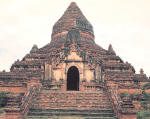
Dhammayazika Stupa, One of Five Axial Shrines
|
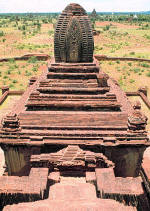
Dhammayazika Stupa, View of shrine tower from bell of stupa
w/pentagonal compound wall in background
|
During the
thirteenth century enormous sums continued to be spent on religious
foundations and their upkeep, although the structures themselves were
often more modest in scale. This practice undermined the economy and
weakened the power of the monarchy since all lands and wealth given to the
clergy was beyond the taxation and control of the King.
In 1274, King
Narapatisithu constructed the last great building at Pagan, the enormous
and beautifully proportioned Mingalazedi Stupa.

Eastern
entrance to Mingalazedi Stupa
In 1287,when the
Mongols appeared on the Northern horizon and threatened to invade Pagan,
King Narathihapati fled the capital and the kingdom fragmented. The
political unity of Burma was thus destroyed and was not regained until the
17th century, although Pagan continued its role as an important
religious center even when later capitals were located elsewhere.
B. City Plan of Pagan
The city of Pagan
unlike the Pyu cities does not have an outer perimeter wall. Instead,
there is a walled compound located in the very bend of the Irrawaddy that
by its small size corresponds to the palace compounds of the earlier Pyu
sites.
|

Side view of Tharaba Gate showing considerable thickness of the
wall. Nat shrines can be seen to the
left. |

Map of Pagon City |
This walled royal
enclosure measures less than a square mile and occupies the Northwest
corner of a twenty-five square mile area over which are scattered more
than 2,000 religious buildings and structures. Within this walled area
were situated the royal palace, court buildings, and a few religious
monuments. Kyanzittha’s royal palace was near the center of the
rectangular enclosure, beside the Thatbyinnyu, the tallest monument at
Pagan and, just inside the city wall from the king’s most famous temple, the
Ananda.
The form of the
royal compound roughly approximates a square Mandala. However, over time
the river has completely washed away the western wall. Within the
remaining walls, two major streets can be traced that originally connected
the four major gates. A large undated stupa is located at its center where
these streets cross.
Recent excavations
have shown that the wall was built in several phases and included massive
gates, guardrooms and hidden passages – all of which were encircled by a
moat. Of the city entrances identified, only the Eastern gate, the
Tharaba Gate, is in a fair state of preservation. Here on either side of
the entrance are found nat shrines, probably added by King Kyanzittha, to
honor the brother-sister heads of the Pantheon of the 36 Nats. These two
Nats in particular are thought to live on Mount Popa, a volcanic cone that
can be seen - on a clear day -some thirty miles east- southeast of the
gate.
|

Tharaba
Gate with Nat Shrine on either side |

Min Mahagiri in shrine at left of gateway |
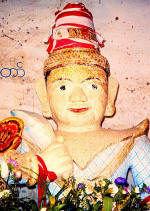
Min Mahagiri, with red and white ties as offerings |
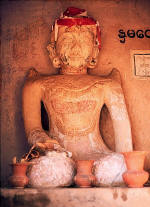
Shwemyethna
in shrine at right of gateway |
|

Shwemyethna,
head and upper torso |

Young novitiates on horseback are shown the two nats at Tharaba Gate
|
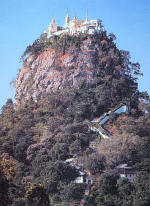
Volcanic plug on slopes of Mt. Popa where nats are thought to live |
|
<Next>
<Table
of Contents> |